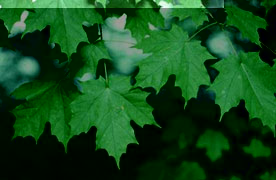


Home
Flowers &
Indoor Plants
Fruits & Nuts
Ornamentals
Vegetables
Special Topics
Resources
Glossary

|
Sugar Maple Acer saccharum (ay-sir sak-air-um)    Click on thumbnails for larger image. |
 |
What about it? The sugar maple is the state tree of New York. It grows up to 70 feet tall. Once again, we find a tree with opposite branches and leaves and double samaras. Sugar maple leaves have 5 prominent lobes but are not as wide as the leaves of the Norway maple. The lobes are smooth and they don't have as many teeth as does the red maple. When a leaf breaks off from the stem a watery sap will be released. The bark of the sugar maple is dark gray with long irregular plates that are often free on one end. The sugar maple has unspectacular yellow flowers in early May and red, orange, or yellow leaves in the autumn. What is it used for? The sugar maples are not as dense as other members of it's family but is still a favorite tree for shade and decoration. It is highly valued for its maple syrup and lumber. Where does it grow? How do we grow it? These trees prefer fertile and moist but well-drained soils. They will not do well in difficult growing sites. In fact, a disorder or disease called "maple decline" occurs if a sugar maple is grown in salty or compacted soils. Stunted growth and scorched leaves are indicative of this situation. What are its primary problems? Maple decline, described above, as well as Verticillium wilt and Anthracnose are the things that you need to worry about with your sugar maple.
© Copyright, Department of Horticulture, Cornell University. |